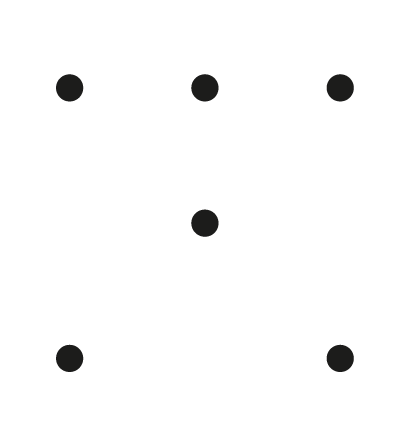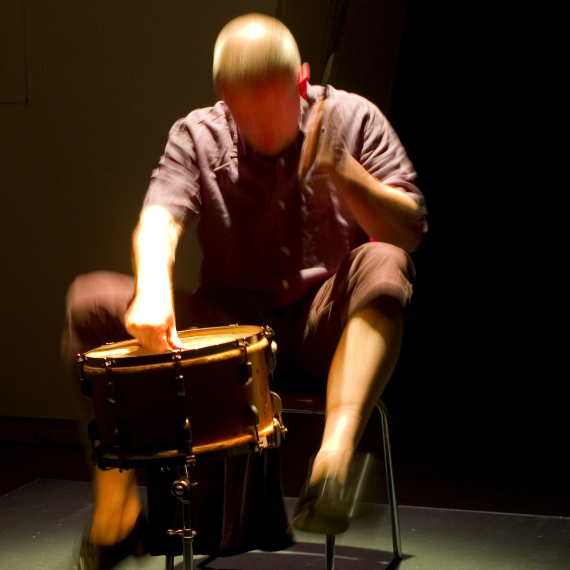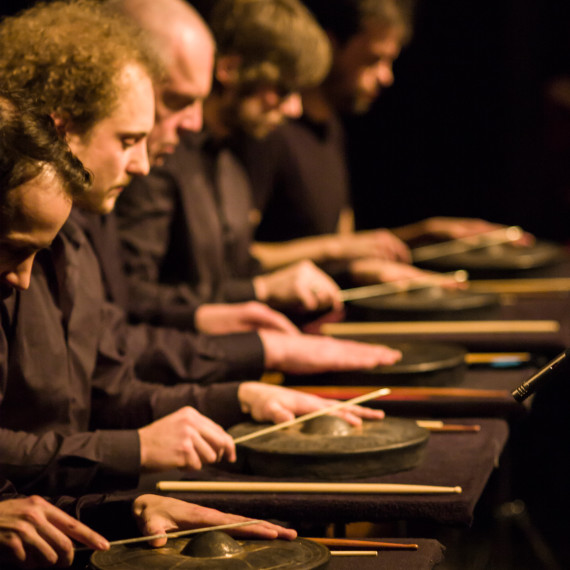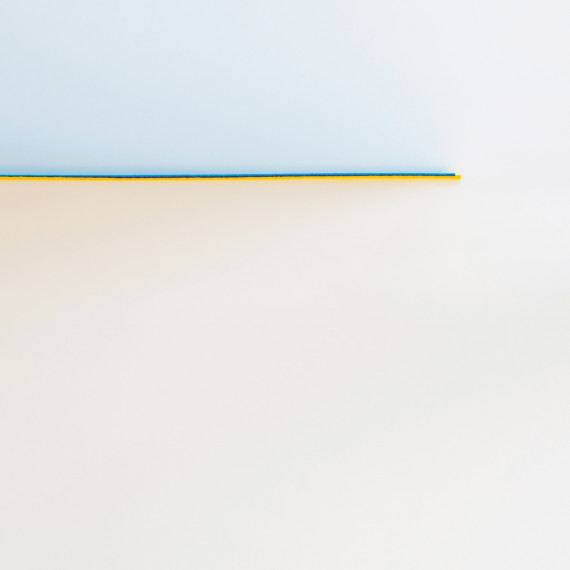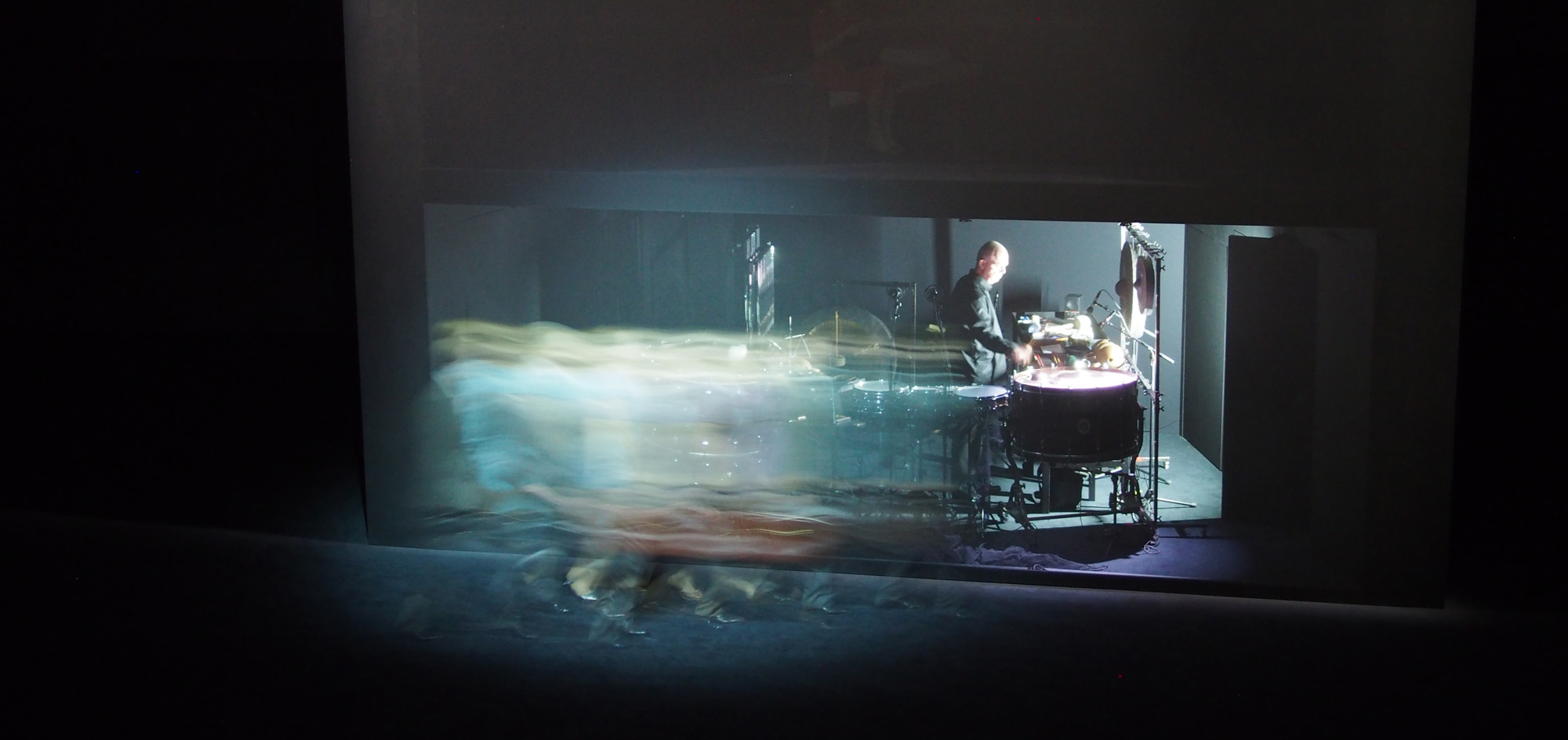
We Spoke: Percussion
“Fritz Hauser is simply one of the best drummers alive”
The New York Times
“Hauser is the contrary of a loudspeaker, he is a softsounder, one who starts by structuring the silence, spreading out the sounds in layers, then progressing to the third dimension, developing himself into the room and finally opening up the fourth: time.”
Frankfurter Rundschau
Different Beat |
for 5 percussionists |
CD 1 |
1. |
Second Thought |
07:38 |
2 - 7. |
As We Are Speaking |
06:29 |
8. |
Double Exposition |
27:25 |
CD 2 |
1. |
Schraffur |
29:26 |
2. |
Rundum |
27:08 |
BUY ALBUM
2 CD + BOOK
Included formats
2 CD + Book (28 pag.) + Voucher Code to download:
HD FLAC Stereo · 24 bit 96 kHz
HD ALAC Stereo · 24 bit 96 kHz
HD FLAC Surround 5.1 · 24 bit 96 kHz
MP3 · 320 kbps
21,90€
Digital Album in CD Quality
Included formats
FLAC Stereo · 16 bit 44,1 kHz
ALAC Stereo · 16 bit 44,1 kHz
MP3 · 320 kbps
10,00€
Digital Album in HD Quality
Included formats
HD FLAC Stereo · 24 bit 96 kHz
HD ALAC Stereo · 24 bit 96 kHz
HD FLAC Surround 5.1 · 24 bit 96 kHz
MP3 · 320 kbps
14,00€
“All these drums are there if you want them. They greatly disturb the peace… And I believe and consider it the truth [that] the devil invented and made them, for there is absolutely nothing pleasant or good about them. On the contrary, [they cause] a smothering and a drowning of all sweet melodies and of the whole of Music.”
Sebastian Virdung
Musica getutscht
Abstract percussion: Fritz Hauser and his different beat
Thomas Meyer
When you look at the huge arsenal of instruments that percussionists have to drag onto the podium, it’s natural to think that they must surely be moonlighting as furniture removers in their spare time. So it’s all the more unusual to see a percussionist walk onto the concert stage carrying a single instrument with him: just one little drum. And especially when he takes out two drumsticks, starts hitting it, and draws forth from it the most incredible musical nuances! The initial astonishment at this act of “downsizing” soon dissipates, and instead you begin to listen attentively as rhythms unfold – whole soundscapes, colours, even melodies. All this emerges out of an improvisation by Fritz Hauser, a man who can almost make us forget the actual, concrete reality of his instrument.
It’s abstraction that he seeks, says Fritz Hauser in conversation: “I don’t find it exciting if drums sound like drums, but when they sound like music. And you know that you’ve achieved this when people no longer wonder: How does he do that?” Hauser can even manage this with an instrument that he does not particularly like, such as the marimba. He leaves behind all effect-laden clichés of its instrumental technique, and instead leads the music into abstraction. And so we hear the musical process, an emission of energy – and not the musician behind it all. Time becomes more important than the instrument itself – time as both stasis and as expansion. The gestation of the music is composed into the music itself, and this helps to lead our ears away from the concrete act of playing the instrument and its sound, to an abstract, musical procedure. The soundfield involved is clearly defined here. He uses straightforward ingredients – just like a cooking recipe – with nothing exotic, but the most precise sound colours and the most precise overtone structures possible (inasmuch as the different instruments involved will allow it). Selecting the instruments and beaters is crucial, as is the attitude to the playing of them: there is an intensity here, a humility towards the music, but the tension is inner, not outer, and there is precision here, too, and suppleness…
Hauser achieves this in compositional terms by notating precisely what he wants. Just as in the three works on this double CD. Almost all of them use sequential forms, though they ingeniously circumvent mere processes of variation by instead orbiting the musical material, as it were, observing it from the outside. And then there are the two conceptual pieces here that unfold out of an idea. They seem to observe the sound from the inside out and lead us deep inside it. If you play a cymbal, nothing much happens, says Fritz Hauser. But if you set two cymbals oscillating at the same time, then the result is a “sheet” of sound far removed from any sense of the percussive act of “striking” an instrument. And “if that happens with seventy cymbals, then they become an ocean, an abstract field”.
Canonic percussion: Second Thought (2011) for three percussionists
The tonal space is wide here – five octaves – but the field of action is narrow: three musicians at one marimba. Each of them is allocated one sector of the instrument. But these sectors overlap and intermesh, which means that the musicians have to coordinate their movements precisely with each other. There is no space here for mere effects.
The piece sets off as if at the shot of a starting pistol: three long, gestural, shifting layers set off, running over each other and then petering out, ebbing away – and then they begin from the start again, first the lowest part, then the other two straight thereafter, with the same series of notes, but staggered in relation to each other. We’re hearing a kind of canon for three voices. A third and a fourth entry follow, and perhaps we might gradually be able to recognize and keep apart in our heads the individual, immensely flexible rhythmic voices, if only the tempo did not begin to slow down already at the second entry, soon to get even slower yet. The impetus of the beginning thus merges into a kind of wavering, rubato-like slow motion (its energy seems to accumulate here); then it quickens pace briefly before slowing down again until it finally – at the fourth entry – enters a space with a very different aura. Now the metal instruments join in (the triangle and cymbals). There is a mysterious moment of calm after which nothing is as it was before. After this, the melodic structure disintegrates gradually, being replaced by glissandi (scales); the metal instruments distract us and take away the final impetus from the motion – and ultimately the music lands on a long, pulsating D flat. Where are we? Where are we going to? How little does it need to keep the energy going?
A coda closes everything, using the series of notes that had been heard before in canon. Is it as if nothing had happened? Or did something happen after all? It’s puzzling.
Speaking percussion: As we are speaking (2004) for four percussionists
The wood speaks. Or, rather: the temple blocks seem to speak. To be sure, it’s more of a babble of voices, a rhythmic palaver, with each percussionist speaking in a different rhythm. The first is in semiquavers, the second in sextuplets, the third in syncopated triplets, the fourth in quintuplets. After just a few bars these rhythms shift again. On the inside, this “speaking” is in motion, restless, but then suddenly it halts – and after a lengthy pause it suddenly sets off again. This moment of pause reminds us of something that we’ve already heard, somewhere quite different, in nature, when the cicadas begin their song and then interrupt it if danger nears, as if on cue. We call it singing, but we could just as well call it speaking or drumming –it’s polyrhythmic. African drummers could be influenced by it. But if you want, you can also think of defective metronomes.
Fritz Hauser had the song of the cicadas in mind – perhaps thinking of some evening in the Piedmont countryside – and he transferred it to the four sets of temple blocks. This is the musical picture behind the work – but is it really a work? These “temple cicadas” know no musical forms, not even any kind of developing form, and yet their music nevertheless undergoes a process of change. In the six sections of this composition, interrupted by these characteristic pauses, Hauser shows us something akin to rhythmic snapshots. Something different happens in every section. Where the disposition of the instruments remains always the same in the first section, the polyrhythms change; in the second section, however, variety comes into play and new speech melodies arise. The third seems to proceed uniformly, though there is a shift in how the beaters are held that is otherwise barely perceptible, but that alters the overtones. In the fourth section, the four percussionists – who had hitherto played two blocks each in rhythmic unison – now become polyphonic themselves. The structure seems to disintegrate in the fifth section. The sixth and last section brings everything together again. And ends abruptly.
Eight-armed percussion: Double Exposition (1996) for four percussionists
“Consider Double Exposition to be a piece for one player with eight arms” is the performance instruction for this piece. Is this an embodiment of the dream of the percussionist who wishes to be a many-armed soloist? Is it perhaps an eight-armed goddess who endeavours to embrace us here? The association is perhaps rather too tangible, but it’s not so wrong either. Fritz Hauser himself speaks of a “strong ritualistic spirit” that is in this piece. It treads onwards, slowly and calmly, in a constant metre, and the instruments used are quite specific, though not as reduced in number as in other pieces.
This piece is structured into twelve parts; the transitions between them are often barely perceptible, but in each of them something fundamental and new happens – it is a cautious process of development. Thus the brief cymbal strokes at the beginning are soon extended by an echo; counterpoints emerge, tremoli and crescendi are heard, there are ritardandi and rests. Thus does this perpetuum mobile wander through time – or perhaps it is us who, listening, are circling the eight-armed goddess, hearing ever new aspects in the music. So this is also a kind of sculptural music, a Calder mobile that is constantly changing, hardly ever coming to a halt, but always either before the beat or after it. In these many layers, foregrounds and backgrounds become audible, independent of each other.
And ultimately you forget just how many percussionists are at work here.
“Hatching” percussion: Schraffur (2015) for gong and percussion quartet
“Hatching” – “Schraffur” – is the act of drawing fine lines close to each other to give the effect of shading. It was one task that we were given in our school drawing lessons that I liked: covering a surface with those lines for so long until it was full of them, using a regular movement that created a gentle, fine, whizzing noise, a rustling, depending on the hardness of the lead of the pencil. Sometimes I never wanted to stop. And it’s this kind of “hatching” that we find in this music. But is it really music? Isn’t it more of a shadowing, a shadow boxing match in sound, emerging into time and then vanishing again? A stretch of time filled with sound, a time span?
“Schraffur” is the name of this concise concept that Fritz Hauser sketched out in 2008 and that he has realised several times since then, in different ways. It is a thoroughly clever concept because it is extremely simple: a crescendo/decrescendo, not unlike the waxing and waning of the moon. No particular explanations are necessary, neither for the musicians nor for the listeners, though it does demand a certain attitude and concentration, and it retains its sensuality, even when it is transferred – effortlessly, it seems – from one instrument to another. I once heard it played by the basel sinfonietta in Lucerne: besides their own instruments, the musicians also used guiros, music stands, instrument cases and other scraping apparatus (if only the cicadas knew of that …). Here the hatching unfolds on five gongs. The identity of the piece is vouchsafed, however. “It is like when you look at clouds: you know that they’re clouds, but they are never the same. You also have to be ready to accept that you will never see them the same again”.
Timeless percussion: Rundum (2011), a concept for percussion ensemble
“Percussion” is in its etymology “to beat thoroughly”, analogue to the German “Schlagzeug” – “beating stuff”. But “percussion”, believes Fritz Hauser, is in fact a “vulgar expression” that has sufficed to discredit a whole musical profession for centuries. It is about putting “beats” in time: rhythm, pulse, even drive, nothing more. But what happens if someone tries to overcome these boundaries by accelerating those impulses, making them into flowing chains so that even the ear – an organ that is so much quicker than the eye – can no longer follow them and only perceives a single, unified sound? What if this sound spreads out like a continuum in time and space, so that we ultimately cannot really perceive any more whence it comes? Then we can create expansive fields of sound colours, even with these “beating” instruments, so that a kind of “timeless stream of sound” emerges – and not just because of the lack of pulse or rhythm. The sound becomes timeless because we no longer recognise where an impulse begins in a given space. The “frontal” situation of the traditional concert is annulled, as are the boundaries between ensemble and audience. Something slightly different can be perceived, wherever you sit or stand. The ears, these organs that let us determine our spatial position, are helpless here. Cause and effect become blurred, all imitation is cancelled out. This is “Rundum” in the true sense of the word: weightless, within itself, shimmering diversely, unfolding and withdrawing again, iridescent. Perhaps Leibniz would have spoken of a monad here: of a unity in which there is no division between substance and accident, between the material and the immaterial, something that cannot be divided into portions but appears always as a whole, even if you only perceive a part of it; it is a characteristic, distinctive, unique specimen, no longer reducible in its simplicity, nothing ready-made, but something constantly changing …
Thomas Meyer
These scores, subject to authors copyright, are available for study. In case you want to perform the pieces, please contact the composer: info@fritzhauser.ch
Second Thought (PDF)
As We Are Speaking (PDF)
Double Exposition (PDF)
“Naturally sounding music in naturally sounding rooms is the concept behind this recording. It brings out the qualities of Fritz Hauser, which are based on precision, care, poetry, and fantasy, in the best possible way. An exquisite production!”
Christoph Wagner / Neue Zeitschrift für Musik
“That Rundum’s seamless continuum of sounds exists at all feels more significant than figuring out its constituent parts. Is the music purely acoustic? Are electronics discreetly bolstering this quiet but insistent hum? The sounds are too richly fascinating to avoid posing such questions, but there comes a point where such analytical listening fades away and your ears dive willingly inside Hauser’s fine-grained adjustments of harmonic interference and minute alterations of timbre. Listening, therefore, becomes a proactive experience.”
Philip Clark / TEMPO
“On the two longer takes Hauser takes part in the playing, ‘Schraffur’ is the youngest creation – for gong and percussion quartet –, a term taken from the visual arts. Executed with 5 gongs a new listening experience is being created. ‘Rundum’ finishes off the album with a kind of ‘timeless sound-stream’. These recordings not only deal with a different kind of listening, they also deal with a different feeling for listening.” 5 Stars
Ruedi Ankli / Jazz’n’more
“Fritz Hauser looks for undetected sounds, hidden in traditional percussion instruments – be it in gongs, cymbals or drums. Brushing instruments against the grain he finds acoustical phenomena nobody knew they were there.”
Christoph Wagner / Woz Zürich
“Hauser soumet sur Rundum des notes que l’on dirait sorties de larges plaques de métal et qui cherchent un équilibre sous un ciel grondant. L’ouvrage-reflet est sombre en conséquence, la densité de son atmosphère n’a d’égal que son épaisseur et, pour dissiper les nuages lourds, il faudra que claquent de grands coups de baguettes. Mais l’équilibre tient bon, et cette mise en place de rythmes étouffés et de pulsations louvoyant impressionne autrement encore.” Read more.
Le Son du Grisli
“Hauser fascina l’oient amb el seu llenguatge musical íntim, detallista, refinat. En la seva música, tot és delicat i res és excessiu. We Spoke en fa una interpretació extraordinària” Read more.
Sonograma Magazine
“El quartet We Spoke materialitza la percussió abstracta del músic suís Fritz Hauser en aquest treball multiformat i acurat de Neu Records. (…) L’oient ja no pensa en la tècnica instrumental de l’intèrpret, ni tan sols en la percussió, sino únicament en el so i la música”
Revista 440 Clàssica
“Rundum, where Hauser seeks to remove all trace of attack from the percussion ensemble: no notes begin or end, but all blend seamlessly into each other. The result could almost be electronic, a gorgeous, hypnotic, slowly-shifting textural soundscape where one quickly abandons trying to work out how things are happening and simply relishes what is.” Read more.
5AGAINST4.COM
“Sonoridades fascinantes, sensibles, que parecen al alcance de la mano, que rememoran pero que pronto se dispersan en la categoría del arte”
Cultura|s. La Vanguardia
Composer
Performers
Serge Vuille
Julien Annoni
Olivier Membrez
Julien Mégroz
Fritz Hauser: Schraffur, Rundum
Second Thought was commissioned by
Synergy Percussion
As we are speaking was commissioned by
Speak Percussion
Double Exposition was commissioned by
Pro Helvetia Swiss Arts Council
Fritz Hauser endorses
Zildjian cymbals
Recorded at
Salle de Musique
La Chaux-de-Fonds
Switzerland, December 2014
We Spoke artistic director and producer
Serge Vuille
Music Production and Sound
N · Santi Barguñó, Hugo Romano Guimarães
Neu Records executive Production
Liner notes
Thomas Meyer
Translations
Chris Walton
Design
Photos
